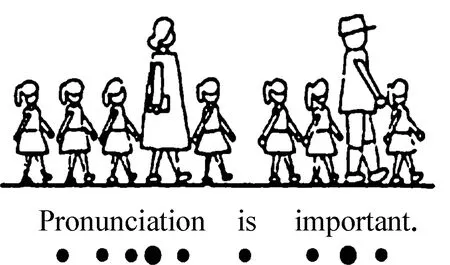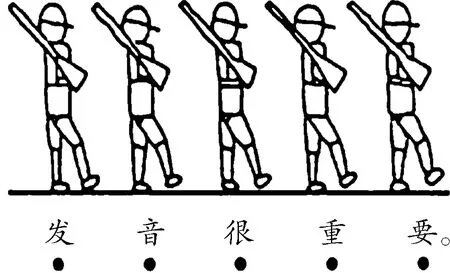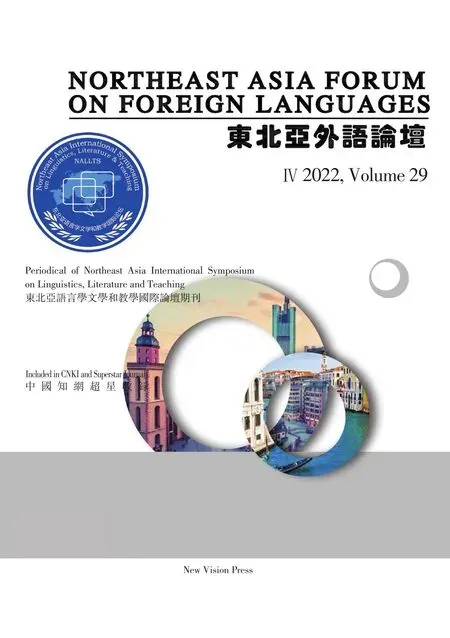The Phonological Gaps of English and Chinese
YANG Cuifen
Shandong Institute of Petroleum and Chemical Technology,Dongying,257061,China
[Abstract] In this essay,I mainly discuss the pragmatic phonetic gaps between English and Chinese as well as the ways to conquer the difficulties the gaps bring.I illustrate how to pronounce the Chinese syllables,the English stressed syllables as well as the weaken syllables;I briefly and clearly point out how to distinguish liaison in spoken English and I first put forward the linking contradiction between spoken English and written English as well as between spoken Chinese and written Chinese;I also illustrate the different features of pitches in spoken English and Chinese.These offers practical help to both English and Chinese learners in improving their listening and speaking and will greatly promote their international communication.
[Keywords] stress-timed rhythm VS syllable-timed rhythm;liaison VS clear-cutting;intonation VS tone
I.Introduction
With rapid globalization,it is important for Chinese or English-native speakers to speak standard English and Chinese to improve mutual communication.Although there are many books or essays investigating the similarities and differences between English and Chinese,most of them focus on grammar,comparing different parts of speech at the lexical level and sentence structures at the syntactic level.Comparatively,there are less texts and essays on the phonological differences of the two languages or they just don’t discuss the differences in detail.
Belonging to different language families,English and Chinese differ in many ways.From the perspective of pronunciation,there are obvious differences between English and Chinese.This essay aims to investigate the phonetic gaps of the two languages from the following aspects: 1.Stress-timed rhythm VS Syllable-timed rhythm.English is considered to be a stress-timed language,in which stresses tend to recur at regular time intervals while Chinese is considered as a syllable-timed language,where all syllables are produced at equal duration.2.Liaison VS Clear-cutting.There are no clear boundary among English syllables and liaison is often formed in speaking and reading,but syllables in the Chinese language have clear-cut boundaries.3.Intonation VS tone.English is a typical intonation language while Chinese is a typical contour tone language.
II.Phonetic Gaps
Phonetic contrasts between English and Chinese are discussed with examples as follows:
1.English stress-timed rhythm VS Chinese syllable-timed rhythm
The syllable refers to a sound unit that can be pronounced independently,usually formed by a vowel with or without one or more consonant.The syllable is an important unit in speaking both English and Chinese.
The stress here is an extra force used when pronouncing a particular word or syllable to give it importance.Stress in an English sentence performs an important role.When native speakers talk,they don’t talk in single words which stop one after another,but talk in groups of words and each group is about the length of a breath.In a group of words,some words are stressed,that is,they are pronounced harder and sound more important.That is,each word in English has a fixed stress pattern,but sentence stress is not as fixed as that.
The nearly equal lengths between stressed syllables form English speech rhythm.
English is considered to be a stress-timed language,in which stresses tend to recur at regular time intervals while Chinese is considered as a syllable-timed language,where all syllables are almost produced at equal duration.This can be illustrated in the following pictures with the English sentence “ Pronunciation is important./prə,nʌsɪ'eɪʃən ɪz ɪm'pɔ:tnt/” and its Chinese expression “发音很重要。/fā yīn hěn zhòng yào/”.In the pronunciation of the English sentence,syllables/prə,nʌsɪ/,/eɪ/,/ʃən ɪz ɪm/and/pɔ:/are produced at almost equal duration,that is,the three syllables/prə,nʌsɪ/and/ʃən ɪz ɪm/have the same duration with the one syllable/eɪ/and/pɔ:/,while in speaking the Chinese sentence,syllables/fā/,/yīn/,/hěn/,/zhòng/,/yào/(each character is a syllable) have almost the same duration.


From the left picture above,we can also see two features of English sentences in pronunciation.(1) The rhythm of English sentences is formed by alternate stressed syllables and weaken syllables;(2) There are less stressed syllables but more weaken syllables.For more examples:
oOooo
I’ve ’eaten them all.
I ’know what it is.
oOooOoo
She ’wanted to ’write to him.
He ’started to ’talk to me.
oOoooO
I ’think it will be ’fine.
She’ll ’try to be in ’time.
Therefore,when speaking English,we shouldn’t produce every syllable with stress as we do in Chinese and most of the syllables should be weaken and spoken more quickly.In fact,the frequent occurrence of unstressed syllables is one of the fundamental characteristics of spoken English.
2.Liaison VS Clear-cutting
English syllables have no clear boundary and often form liaison in speaking and reading.On the other hand,syllables in the Chinese language have clear-cut boundaries.For example,in speaking the sentence “Pronunciation is important.”,we usually pronounce it like “Pronunciation‿is‿important.”,which means there is liaison between the three words due to “the consonant + vowel” linking in English pronunciation.However,in speaking or reading the Chinese sentence“发音很重要”,there are clear-cut boundaries among each character or each syllable.
Here are the major linking rules I conclude in speaking or reading English.
(1) Consonant + Vowel Linking
It refers to the linking of the final consonant of a word and the initial vowel of the following word.
For examples:
Hold‿on!
You only look‿at me and‿I was yours.
I’ll make‿ it‿ okay.
I’ll chase them‿ away.
(2) Consonant + Consonant Linking
In connected speech when a plosive consonant like/p//b//t//d//k//g/,is followed by another consonant,it is not fully pronounced;and when a consonant is followed by the same consonant,the same sounds join together to create a slightly stronger consonant.
For examples:
I’m a bi(g) bi(g) girl.
Ro(b) Peter to pay Paul.
Ge(t) down!
Qui(t)e cheap.I’ll ta(k)e them.
I nee(d) quite a lot.
I(t) took him twenty years to ge(t) to the top.
When will the sky sto(p) to rain.
(3) Consonant + Semivowel Linking
When a consonant like/t//d//s//z/is followed by the semivowel/j/,the two sounds are assimilated to create new consonants/tʃ//dʒ//ʃ//ʒ/.
For examples:
don’t you/t/+/j/=/tʃ/
did you/d/+/j/=/dʒ/
pass you by/s/+/j/=/ʃ/
lose you/z/+/j/=/ʒ/
(4) Vowel + Vowel Linking
V+V linking refers to the linking of the final vowel,such as/ʊ//u://aʊ//əʊ/and the initial vowel of the following word by inserting a/w/,or the linking of the final vowel,such as/i://ɪ//aɪ//ɔɪ//ei/and the initial vowel of the following word by inserting a/j/.
For examples:

What is interesting is,in written English there are obvious space between English words,but in speaking English,we need to link words together according to these linking rules;while in written Chinese,there are no boundaries among each character,but we should speak each character with clear-cut boundaries.
We usually think linking occurs among words in English sentences,but Professor Guo Xiping (2020) of Inner Mongolia Normal University first put forward clearly in his book21st Century College English Phonetics Coursethe phenomenon that linking also exists in some English words.
For examples:
C+V linking: unable,disappointed,pineapple,self-interest
C+C linking: em(p)ty,foo(t)ball,lo(ck)ed,goo(d)-looking
C+SV linking: during,altitude,substitute,student
V+V linking: going,coincidence,tired,reality
The English liaison poses most of the difficulties for Chinese people to listen and speak English because most of them are ignorant of this feature of spoken English.
3.Intonation VS tone
English is a typical intonation language while Chinese is a typical contour tone language.That is,different pitches in English are intonational in nature and indicate post-lexical meanings,while those in Chinese indicate lexical meanings.Lexical intonation,or the tone is more important in Chinese,as it is used for distinguishing meaning.
In English,though a word can be read in any intonation without changing meaning,the speaker adopts different intonations to express different intentions which lexical and syntactic structure cannot express: a rising intonation often reveals the speaker’s doubt or question,and a falling intonation means a statement or special question.A changing intonation—rising-falling,falling-rising,the flat tone—may express some special or implied meaning.This can be illustrated by the examples in the following chart.

Sentence Meaning/Feeling Context 1.My wife is pregnant.↘ statement She can’t drink wine.2.My wife is pregnant.↗ uncertainty Did I hear you correctly,doctor?3.My wife is pregnant.↘↗ disbelief But she is 59 years old!4.My wife is pregnant.↗↘ enthusiasm This is our first child.4.My wife is pregnant.→ uninterested So what? This will be our twelfth.
The Chinese language is viewed as a “tonal language”.Chinese characters are of four tones(四声)—the high and level tone(阴平,the rising tone(阳平),the falling-rising tone(上升) and the falling tone(去声),as in 妈,麻,马,骂.The pitches of the four tones may be shown vividly with 5 levels in the following chart.

The high and level tone pitch is the highest from level 5 to 5.The rising tone pitch is from the middle to the high level(35)(not from the low to the high) while the falling tone is from level 5 down to level 1.The falling -rising tone pitch is first from the half-low to the low and then rises to the half-high level(214).
Also,there is the neutral tone(轻声)—modal particles“吧,吗,啊,呢......”,as in“走吧”,“说啊”etc.;auxiliary words“着,了,过,的,们......”,as in“我的”,“来了”,“我们”etc.;noun suffixes“头,儿,子......”as in“甜头”,“桌子”etc.;reduplicated words,as in“走走”.In Chinese,the speaker’s doubt or question is often expressed by using interrogative marker 吗 at the end of a sentence.
In spoken Chinese,the tones may change,which especially occurs on the character of the falling-rising tone.When two characters of the falling-rising tones are together,the first one would sound like the rising tone,that is,理想(lǐ xǐang) sounds like 理想(lí xǐang),海水(hǎi shuǐ) sounds like (hái shuǐ),and 想你(xiǎng nǐ) sounds like 想你(xiáng nǐ).When one character of the falling-rising tone is followed by a character of any of the rest three tones,the falling-rising tone sounds half of falling-rising tone,the falling part(21).For examples: 首都(shǒu dū) sounds like 首都(shòu dū),打球(dǎ qíu) sounds like 打球((dà qíu),and 法律(fǎ lǜ) sounds like 法律(fà lǜ).Here we must be aware that the falling part tone is (21),not(51).
The high and level tone of character “一(yī)” changes with its following characters.When “一(yī)” is followed by a character of falling tone,it is pronounced the rising tone,as in 一样(yí yàng)、一个(yí gè).When“一(yī) is followed by any of the rest three tones,it sounds the falling tone,as in 一天(yì tiān、一年 (yì nián)、一起 (yì qǐ).And when “一(yī)” is between two same verbs,it is pronounced the neutral tone,as in 看一看(kān yi kān)、数一数 (shǔ yi shǔ).
Tones in the Chinese language have aesthetic function.The four tones of Chinese in four character phrases have musical effect.Here are some examples:
心明眼亮(xīn míng yǎn liàng)、兵强马壮(bīng qiáng mǎ zhuàng)、光明磊落(guāng míng lěi luò)、胸怀广阔(xiōng huái guǎng kuò)
Intonation mainly concerns the syntactic level and is used to distinguish questions from statement.In this respect,English and Chinese have much similarity.The rising intonation often indicates a question,sometimes without changes in the grammatical structure of the English sentence or adding the interrogative marker 吗 in the Chinese sentence.
The Chinese tone system often poses great difficulties for foreigners to speak Chinese.However,we can mostly understand them when their tones are not spoken correctly.This is because the flow of the sentence will help in understanding what is said.
III.Conclusion
This essay is not very theoretical but rather provides detailed contrast of Chinese and English concerning pronunciation.The practical study of phonological differences of English and Chinese from stress,liaison,rhythm,intonation and tone will help English-native learners and Chinese-native learners be aware of the respective characteristics of Chinese and English pronunciation.And in such circumstances,with hard practices,learners are able to master correct pronunciation skills and greatly improve their listening and spoken language and then promote their international communication.
- 东北亚外语论坛的其它文章
- 基于语篇分析理论的初中英语读写教学设计
——以“人教版Go For it九年级Unit 5 Beauty in Common Things”阅读语篇为例 - The Attitudes and Strategies of EFL Parents of Public Kindergarten Children in Suburban Shanghai Toward Their Children's English Learning
- 新文科背景下译者信息素养框架的构建与教学实践
- 语料库辅助大学英语听力教学初探
- 2021NALLTS综述
- 基于认知语言学视点的日语示证性语义范畴研究
——以“~っぽい”为例

